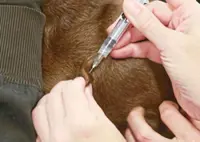Siewe is a professional hunter of the invasive Burmese python in Florida. — Photos: Reuters
Amy Siewe was a successful real estate agent – but her life changed after she captured her first python in Florida’s Everglades in the United States.
“I just had this fascination with snakes. So when I learned that there was a python problem here in Florida... I went on a hunt, I caught a 2.75m python, and that was it. I was hooked!” she said.
Within two months she had sold her business in Indiana and moved to Florida to become a python hunter.
Now, with more than 600 dead pythons under her belt, she is known as the “Python Huntress” – one of a handful of women among hundreds of men hunting the invasive Burmese python in Florida’s Everglades wetland ecosystem.
“This python is about 3m long,” she says as she wrestles a snake she has just captured in the tall grass in the middle of the night. “It’s probably about three years old, and to date it’s eaten about 200 of our native animals, including mammals and birds.”
Burmese pythons have been spreading through the Everglades National Park since Hurricane Andrew in 1992 destroyed a breeding facility for the pet trade, freeing some 900 snakes.
Originally native to South-East Asia, the python can grow up to 5.5m long and has a voracious appetite, consuming the local wildlife, including mammals, birds and even alligators.
The Everglades is a unique subtropical ecosystem, with the largest continuous mangrove ecosystem in the Western Hemisphere. It is home to a vast array of unique species, including the endangered Florida panther, the American alligator and the American crocodile.
But it provides no natural predators to the Burmese python, allowing the population of the invasive species to balloon. Scientists have noted dramatic declines in raccoons, opossums, bobcats, and rabbits in the region.
“There’s an estimated 500,000 pythons out there,” Siewe said.
The pythons, which are hunted by night, cannot legally be transported alive, so they are killed on site after being captured and measured.
Once home, Siewe skins the dead snakes, and then has the skins professionally tanned into leather to be made into purses, wallets, watch bands and other goods.
It takes an average of 12 hours to catch one.
“So it’s not that effective, right,” she admits. “We’re always going to have pythons in Florida. What we’re trying to do is figure out how to decrease their numbers. Hunting right now is the most effective tool that we have.” – Reuters







